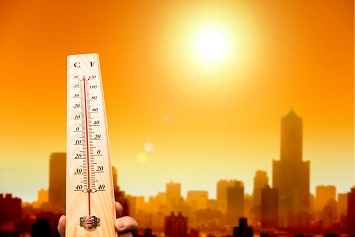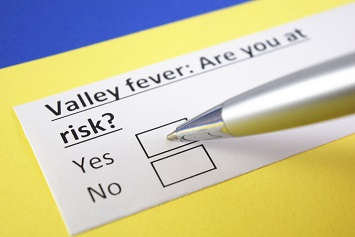Concerns are growing about two occupational health issues: the increased incidence of heat stress and valley fever, a fungal lung infection caused by exposure to dust storms and excavated soil. Cases of valley fever may be spreading beyond the southwestern United States. Some federal agencies and nongovernmental groups claim the rise in heat-related illness and valley fever cases are being driven by climate change.
Heat Stress
High temperatures and humidity can result in a number of work-related illnesses, including the following:
- Heat rash, one of the most common but not life-threatening conditions, is caused by sweating and looks like a red cluster of pimples or small blisters;
- Heat cramps are muscle pains caused by the loss of body salts and fluid from sweating due to physical labor in a hot work environment;
- Heat exhaustion, the result of the body overheating, can cause dizziness, headache, nausea, and weakness that can make a worker susceptible to other injuries; and
- Heatstroke, the most serious heat-related health problem, happens when the body’s temperature-regulating function fails; it is a medical emergency and can cause death.
Although there is no federal heat stress or heat illness prevention standard, the National Institute for Occupational Safety and Health (NIOSH) developed a recommendation for one shortly after the institute was formed.
NIOSH regularly reviews medical literature on workplace safety and health hazards and then develops “criteria documents” for recommended standards that the Occupational Safety and Health Administration (OSHA) can then adapt into proposed regulations.
NIOSH first developed a criteria document for a heat stress standard in 1972. The Criteria for a Recommended Standard: Occupational Exposure to Hot Environments was revised in 1986. A further revised NIOSH Criteria for a Recommended Standard: Occupational Exposure to Heat and Hot Environments was released in February 2016. The 2016 revision includes information from more recent studies, including the effects of caffeine use, a redefinition of heatstroke and its symptoms, updated monitoring methods, and descriptions of new personal protective equipment and clothing to help control heat stress.
OSHA addresses heat stress hazards under the General Duty Clause of the Occupational Safety and Health Act. The General Duty Clause requires that an employer “furnish to each of his employees employment and a place of employment which are free from recognized hazards that are causing or are likely to cause death or serious physical harm to his employees.”
OSHA typically cites employers after an employee has died or has been hospitalized due to heat-related exposure. Groups within and outside the government have criticized OSHA for failing to establish a heat stress or heat illness prevention standard.
Public Citizen earlier this year followed up a 2018 petition for a heat exposure standard with letters to the secretary of Labor and the head of OSHA calling for a federal standard. Public Citizen claims that without a specific regulation, employers are not inclined to protect workers from heat stress and heat illness.

State Standards
Although there is no federal heat exposure standard, some states have their own heat stress or heat illness prevention regulations. California and Washington have regulations governing heat exposures for outdoor workers. Minnesota has its own standard for hot and cold conditions in indoor work environments. California is developing a new standard for heat exposure in indoor environments.
The existing California and Washington regulations have recordkeeping and training requirements. Both require employers to provide 1 quart of water per worker per hour to ensure proper hydration. The Washington state rule is effective May 1 to September 30 each year. The California standard is more stringent, applying year-round. The California standard also has proactive monitoring, rest, and shade requirements.
Minnesota has heat exposure limits based on levels of work exertion and an index of combined air temperature, air speed, humidity, and radiation.
Resources for Employers
OSHA and NIOSH developed a Heat Safety Tool smartphone app available for both Android phones and iPhone® devices. Using the app, employers can plan outdoor work activities based on the temperature and heat index during different times of the day. The app provides real-time heat index levels and hourly forecasts specific to a user’s location, as well as occupational safety and health recommendations for hot conditions from OSHA and NIOSH. The app is available from the Apple App Store and Google Play store.
Other resources available from OSHA include a guide for training workers; an OSHA-NIOSH fact sheet that can be used as a handout; an English and Spanish training poster; and an English, Spanish, and Vietnamese Quick Card for employers and supervisors.
In addition to the criteria document for a recommended standard, the heat stress app, and the OSHA-NIOSH information sheet, other NIOSH resources include a heat illness prevention poster, a four-page report for supervisors that includes case studies, and “Fatality Assessment and Control Evaluation” and “Health Hazard Evaluation” reports.
Valley Fever Beyond the Desert
Valley fever (also known as California fever, desert rheumatism, and San Joaquin fever) is a respiratory infection caused by Coccidioides fungi that grow in the soil. The spores become airborne when soil is disturbed by wind or digging, excavation, or other construction activity.
Outdoor workers, especially construction workers, are at risk of valley fever infections. Cal/OSHA has cited employers both for failing to protect workers from Coccidioides spores and for failing to report cases of work-related valley fever.
For decades, valley fever or Coccidioidomycosis cases were confined to the southwest states of Arizona, California, Nevada, New Mexico, Texas, and Utah. Cases have been tracked in the Southwest since the 1930s and 40s.
However, valley fever has since been diagnosed in southeast, central Washington State. Public health officials are concerned cases may be popping up in other parts of the country. Alabama, Arkansas, Delaware, the District of Columbia, Indiana, Kansas, Louisiana, Maryland, Michigan, Minnesota, Missouri, Montana, Nebraska, New Hampshire, North Dakota, Ohio, Oregon, Rhode Island, South Dakota, Washington, Wisconsin, and Wyoming all have valley fever public health reporting requirements.
Federal researchers speculate that climate factors like drought may be widening the endemic range of valley fever. They claim more prolonged or intense droughts resulting from climate change could lead to improved conditions for the spread of Coccidioides spores. California health officials suspect prolonged droughts and decreased snowpack in the Sierra Nevada area have led to cases of valley fever spreading to areas of the state beyond the Central Valley.
What is Valley Fever?
Valley fever can be mild, and some patients show few symptoms and never seek medical attention. More serious infections result in bronchitis or pneumonia. Disseminated valley fever, the most serious and potentially fatal cases, can spread to bones, brain tissue, joints, skin, and other organs.
Workers at risk for valley fever infection include construction workers and farmworkers, correctional officers, military personnel and trainees, wildland firefighters, and workers in mining and oil and gas extraction.
Naval medical personnel diagnosed valley fever in 22 Navy SEALs exposed during training.
Workers in clinical microbiology laboratories may also be at risk. NIOSH recommends that labs have comprehensive prevention plans in place to protect laboratory workers.
California epidemiologists have even diagnosed work-related valley fever among cast and crew members of a television production.
Worksite controls to prevent valley fever infection include:
- Stopping work during dust storms or high winds;
- Staying upwind of digging if possible;
- Minimizing hand digging and substituting digging with heavy equipment with enclosed, air-conditioned, high-efficiency particulate air (HEPA)-filtered cabs;
- Continuously wetting soil while digging or moving earth;
- Covering excavated soil with tarps;
- Washing equipment before it is moved off-site;
- Providing lockers and requiring that workers change clothing and shoes at the worksite to prevent workers from taking dusts and spores home;
- Providing workers with respiratory protection, such as NIOSH-approved half-mask respirators with N95, N100, or P100 filters, when other controls are impractical or ineffective; and
- Implementing a fit-testing and training program that meet state or federal respiratory protection program requirements.
NIOSH recommends setting up a respiratory protection program and providing respirators to workers who dig manually, dig using equipment (including heavy equipment with enclosed cabs), or work near earthmoving trucks or equipment.
Symptoms of valley fever are similar to the flu and include fatigue, shortness of breath, and fever. Other symptoms can include headache, muscle aches or joint pain, night sweats, and rash on the upper body or legs. An employee reporting flu-like symptoms lasting longer than 1 week should see a medical professional for testing and treatment.
If the worker’s duties include work outside in areas where valley fever is endemic, then you should report the illness to the appropriate state or federal occupational safety and health agency.

Join us at the 2019 Cal/OSHA Summit to learn more about current safety regulation and compliance trends in California! Click the image above to register today.
Valley Fever Resources
Because valley fever may be acquired through both work and nonwork activities, resources are available from both occupational and public health agencies. The California Department of Public Health has a guide for giving tailgate talks for wildland firefighters, as well as Occupational Health Branch (OHB) prevention fact sheets and posters for other workers. The OHB also developed a continuing medical education course in occupational valley fever. The Centers for Disease Control and Prevention (CDC) published a review in 2018 of outbreaks of valley fever from 1940 to 2015. The CDC also has a collection of resources on a valley fever webpage.


